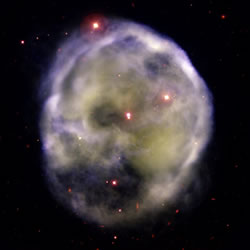Skull Nebula (NGC 246)

NGC 246. Credit: Gemini South GMOS image / Travis Rector University of Alaska Anchorage.
The Skull Nebula (NGC 246 is a planetary nebula in the constellation Cetus. NGC 246, nicknamed the Skull nebula, was discovered in 1785 by William Herschel. It lies approximately 6° north-northeast of the 2nd-magnitude star Beta Ceti and about 1.5° south-southeast of 4.8-magnitude Phi1 Ceti.
The nebula is relatively small and dim (11th-magnitude). In a small telescope the nebula's feeble light is almost overpowered by the foreground stars superimposed on it. Larger telescopes show the nebula more clearly, especially with an oxygen III filter. NGC 246's central star (a white dwarf) is worth monitoring. In 1930, its photographic magnitude was as bright as 9th magnitude. In 1969 it dipped to 11.2 and today it shines at about 12th magnitude. This star is also is part of a binary pair.
The complex braided structure of NGC 246's blue outer ring, visible in this image taken by the Gemini South telescope, is thought to result from the action of shock waves. As the compressed outer shell piles up against the interstellar medium, it heats up and becomes unstable causing it to fragment. High-velocity gases pushing outward from the hot (~200,000 K) central star may also contribute to the visible chaos. Collisions between these fast winds and the shocked shell could explain the distinctive green lobes and darker voids visible in the leading half of NGC 246's interior shell.
The unequal expansion along the nebula's major axis results in a visible asymmetry: as the image here shows, NGC 246's outer structure is shaped like an oval ring. Its leading (top) edge appears brighter and sharper than its trailing (bottom) edge. The central binary star is slightly displaced toward the shell's leading edge, as astronomers predicted. (For more details on the dynamics of planetary nebulae, and this object in particular, see the papers by Muthu et al. and Soker et al.)
| visual magnitude | 10.9 |
| angular diameter | 4.6' × 4.1' |
| distance | 1,600 light-years |
| position | RA 00h 47m 20s; Dec -11° 50' 24" |


